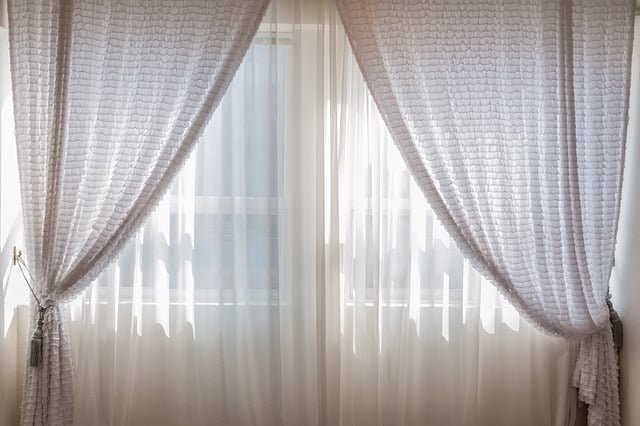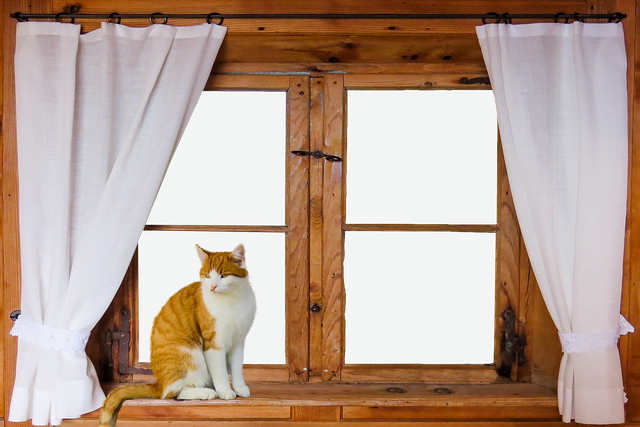Curtains have been a staple in homes for centuries, serving both practical and aesthetic purposes. From blocking out light and providing privacy to adding a pop of color or texture to a room, curtains have many uses. However, did you know that curtains also hold spiritual significance in some cultures?
In many ancient traditions, curtains were used to separate sacred spaces from the mundane world. They were often made of fine fabrics and adorned with intricate designs, serving as a physical barrier between the physical and spiritual realms. In some cultures, curtains were also believed to have protective qualities, shielding the home and its inhabitants from negative energy or evil spirits.
Today, the spiritual meaning of curtains continues to be recognized in various practices. Some people use curtains as a way to create a sacred space in their homes for meditation or prayer. Others choose curtains with specific colors or patterns that hold symbolic significance in their culture or belief system. Whether you are aware of it or not, the curtains in your home may hold a deeper meaning beyond their practical use.

Understanding Spiritual Significance
As we explore the spiritual significance of curtains, it is important to approach the topic with an open mind and a willingness to learn. While some may view curtains as simply a functional item used to cover windows, they can hold deeper meaning and symbolism.
In many spiritual traditions, curtains are seen as a way to create a sacred space or to separate the physical world from the spiritual realm. They can be used to create a sense of privacy and intimacy, allowing individuals to connect with their inner selves or with a higher power.
Curtains can also be seen as a symbol of transformation and change. Just as we can open or close curtains to let in or block out light, we have the power to make choices that can impact our lives and our spiritual journeys.
Additionally, the colors and materials used in curtains can hold significance. For example, white curtains may represent purity and innocence, while red curtains may symbolize passion and energy.
Overall, understanding the spiritual significance of curtains can provide us with a deeper appreciation for their role in our lives and in our spiritual practices.
Curtains in Spirituality
Curtains have been used for centuries as a way to enhance the spiritual atmosphere of a room. In many cultures, curtains are seen as a way to create a sense of privacy and intimacy, which can be conducive to prayer, meditation, and spiritual reflection.
In some spiritual traditions, curtains are used to symbolize the veil that separates the physical world from the spiritual realm. The act of opening and closing curtains can be seen as a ritualistic way of crossing this veil and entering into a more sacred space.
Additionally, the colors and patterns of curtains can also hold spiritual significance. For example, in Hinduism, the color red is associated with passion and desire, while the color white is associated with purity and transcendence. Similarly, in Buddhism, the lotus flower pattern is often used on curtains to symbolize enlightenment and spiritual growth.
It’s important to note that while curtains can be a powerful tool for enhancing the spiritual atmosphere of a space, they are not a substitute for genuine spiritual practice. Rather, they should be used as a way to complement and support one’s spiritual journey.
In conclusion, curtains have a rich history in spirituality and can be a powerful tool for enhancing the spiritual atmosphere of a space. By understanding their symbolism and meaning, we can use curtains to create a more sacred and intentional environment for spiritual practice.
Symbolism of Curtains
Curtains have been used for centuries to decorate homes and provide privacy. However, they also hold spiritual significance in many cultures. Here are a few examples of the symbolism of curtains:
- Protection: In many traditions, curtains are believed to provide protection from negative energy and evil spirits. They are thought to act as a barrier between the outside world and the inner sanctum of the home, keeping unwanted energy out and allowing positive energy to flow freely.
- Transition: Curtains are often used to mark a transition from one space to another. For example, they may be used to separate a sacred space from the rest of the home, or to create a sense of privacy in a bedroom. They can also be used to mark the transition from one phase of life to another, such as the transition from childhood to adulthood.
- Concealment: Curtains can also be used to conceal something that is hidden or secret. For example, they may be used to hide a doorway or a window, or to conceal a private space within a larger room. In this way, curtains can symbolize the need for privacy and the importance of keeping some things hidden from view.
- Decoration: Finally, curtains can be used simply as a decorative element, adding color and texture to a room. They may be used to complement the other elements in a space, such as the furniture and artwork, or to create a focal point in their own right.
Overall, curtains hold a deep spiritual significance in many cultures, symbolizing protection, transition, concealment, and decoration. By understanding the symbolism of curtains, we can gain a deeper appreciation for their role in our homes and in our lives.
Curtains in Different Cultures
Eastern Interpretations
In many Eastern cultures, curtains are seen as a symbol of privacy, protection, and respect for personal space. In Japan, for example, curtains are often used to separate different areas of a home, such as the living room and the bedroom. These curtains, called noren, are often decorated with symbols and motifs that represent good luck, prosperity, and happiness.
In India, curtains are often used in religious ceremonies and festivals. They are also used in homes and temples to create a sense of privacy and separation. In Hinduism, curtains are often used to separate the sacred space from the rest of the world. These curtains, called torans, are often decorated with auspicious symbols and motifs.
Western Interpretations
In Western cultures, curtains are often seen as a decorative element that adds style and elegance to a room. They are also used to control the amount of light that enters a room and to provide privacy. In Europe, curtains are often made of heavy fabrics and are used to keep out the cold and to create a cozy atmosphere.
In the United States, curtains are often used to add color and texture to a room. They are also used to create a sense of privacy and to block out light. Curtains are often paired with blinds or shades to provide additional light control.
Overall, curtains have a rich and varied spiritual meaning in different cultures around the world. Whether they are used for decoration, privacy, or protection, curtains play an important role in our homes and in our lives.
Curtains in Religious Texts
Curtains have been mentioned in various religious texts throughout history. In many cases, curtains are used to symbolize separation or protection from the divine.
In the Old Testament, curtains were used in the Tabernacle as a way to separate the Holy of Holies, where the Ark of the Covenant was kept, from the rest of the Tabernacle. This separation symbolized the separation between God and man, and the curtains acted as a barrier between the two.
In the New Testament, curtains are mentioned in the Gospel of Matthew during the crucifixion of Jesus. It is said that the curtain in the temple was torn in two from top to bottom at the moment of Jesus’ death. This tearing of the curtain symbolized the removal of the separation between God and man, and the opening of access to the divine.
In Islam, curtains are often used in mosques to separate the prayer area from the rest of the space. This separation symbolizes the sacredness of the prayer area and the need for focus and concentration during prayer.
Overall, curtains have played an important role in religious symbolism throughout history. They have been used to represent separation, protection, and access to the divine.
Color Symbolism in Curtains
White Curtains
White curtains symbolize purity, innocence, and spirituality. They are often used in meditation spaces, religious buildings, and healing centers. White curtains can also represent new beginnings and a fresh start, making them a popular choice for weddings and other ceremonies.
Red Curtains
Red curtains symbolize passion, energy, and power. They can add a bold and dramatic touch to a room, but should be used sparingly as too much red can be overwhelming. In some cultures, red is associated with luck and prosperity, making red curtains a popular choice for businesses and homes.
Black Curtains
Black curtains symbolize mystery, elegance, and sophistication. They can create a sense of drama and intrigue in a room, but should be balanced with lighter colors to prevent the space from feeling too heavy. Black curtains can also represent mourning and sadness, so they are not always appropriate for celebratory occasions.
That’s all for our brief section on color symbolism in curtains. Remember, the meanings of colors can vary depending on culture and personal interpretation, so it’s important to choose colors that resonate with you and the mood you want to create in your space.

Curtains in Dreams
Dreams are a fascinating and mysterious aspect of our lives. They can reveal hidden truths, desires, and fears that we may not be aware of in our waking lives. Curtains in dreams can have various interpretations, depending on the context and symbolism involved.
One common interpretation of curtains in dreams is that they represent a barrier or boundary between the dreamer and the outside world. The curtains may symbolize the dreamer’s desire for privacy or protection from unwanted attention. Alternatively, they may represent a fear of being exposed or vulnerable to others.
Another interpretation of curtains in dreams is that they represent a transition or change in the dreamer’s life. The act of opening or closing curtains can symbolize the beginning or end of a chapter in the dreamer’s life, such as the end of a relationship or the start of a new job.
The color of the curtains in the dream can also be significant. For example, red curtains may symbolize passion or intense emotions, while white curtains may represent purity or innocence.
Overall, curtains in dreams can have a variety of meanings depending on the context and symbolism involved. It is essential to consider the dreamer’s personal associations with curtains and how they relate to their waking life to gain a better understanding of the dream’s meaning.
Interpreting Curtain Imagery
Curtains can hold a variety of spiritual meanings, depending on the context in which they are presented. Here are a few interpretations of curtain imagery:
- Concealment: Curtains can represent a barrier between the viewer and something that is being concealed. This could be a physical object or a hidden truth. The act of drawing back the curtains can represent the revelation of knowledge or the unveiling of a secret.
- Transition: Curtains are often used to mark transitions between different spaces or states of being. For example, a stage curtain can represent the boundary between the world of the audience and the world of the performers. In this sense, curtains can represent the liminal space between two worlds.
- Privacy: Curtains can also represent a desire for privacy or solitude. A drawn curtain can indicate a need to be alone or a desire to shield oneself from the outside world.
- Decoration: Finally, curtains can serve a purely decorative function. In this case, the spiritual meaning of the curtain may be less important than its aesthetic value.
These are just a few examples of the many ways in which curtains can be interpreted spiritually. As with any symbol, the meaning of curtains will vary depending on the context in which they are presented. By paying attention to the details of the image, we can begin to uncover the deeper meanings that lie beneath the surface.
Conclusion
In conclusion, curtains have a deep spiritual meaning that goes beyond their practical use of blocking light and providing privacy. Throughout history, curtains have been used in various cultures and religions to symbolize different things, such as the veil between the physical and spiritual world, the separation of the sacred and the profane, and the protection from negative energies.
We have explored the spiritual meanings of different types of curtains, including lace curtains, blackout curtains, and sheer curtains. Lace curtains are often associated with femininity, purity, and delicacy, while blackout curtains are linked to darkness, mystery, and privacy. Sheer curtains, on the other hand, represent transparency, lightness, and openness.

Frequently Asked Questions
We have also discussed the importance of color in curtains and how different colors can evoke different emotions and energies. For example, red curtains can symbolize passion, power, and courage, while blue curtains can represent tranquility, calmness, and spirituality.
Overall, curtains can be a powerful tool for enhancing the energy and atmosphere of a space. By choosing curtains that align with our spiritual beliefs and intentions, we can create a more harmonious and balanced environment that supports our physical, emotional, and spiritual well-being.
What does the curtain symbolize in the Bible?
In the Bible, the curtain or veil is often used as a symbol of separation between God and humanity. It represents the barrier that existed between God and people before the coming of Christ. The tearing of the veil in the temple at the moment of Jesus’ death symbolizes the removal of this barrier and the opening of the way to God.
What are curtains meant for?
Curtains are primarily used for privacy, to block out light, and to decorate a room. They can also be used to regulate temperature and sound. In a spiritual sense, curtains can represent a barrier or separation between the physical and spiritual realms.
What is the meaning of curtain in the dream?
In dreams, curtains can symbolize the need for privacy or the desire to hide something. They can also represent a barrier or obstacle that needs to be overcome. The color and condition of the curtains in the dream may provide additional clues to their meaning.
What do white curtains represent?
White curtains can represent purity, innocence, and simplicity. They can also symbolize a desire for clarity or a new beginning. In a spiritual sense, white curtains may represent a desire for spiritual purity or a connection with the divine.
What is the spiritual significance of burning curtains in a dream?
Burning curtains in a dream can represent the destruction of a barrier or obstacle. It can also symbolize the release of pent-up emotions or the need for change. In a spiritual sense, burning curtains may represent the destruction of negative energy or the purification of the soul.
What is the interpretation of a dream about taking down curtains?
Taking down curtains in a dream can represent the removal of a barrier or the end of a period of isolation. It can also symbolize the need for change or the desire to let in more light. In a spiritual sense, taking down curtains may represent the opening of the way to the divine or the breaking down of barriers that separate us from God.





